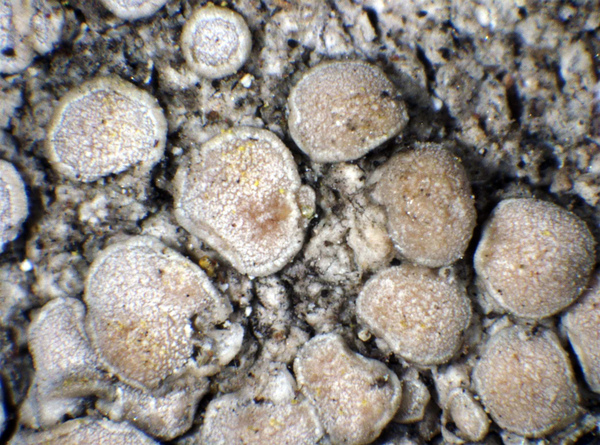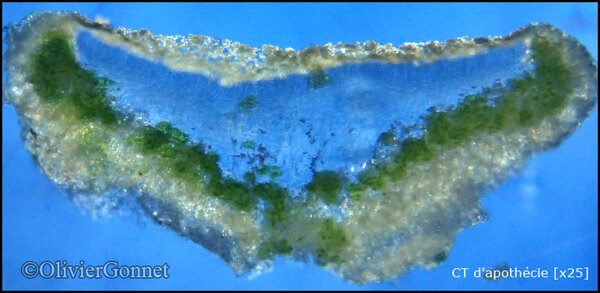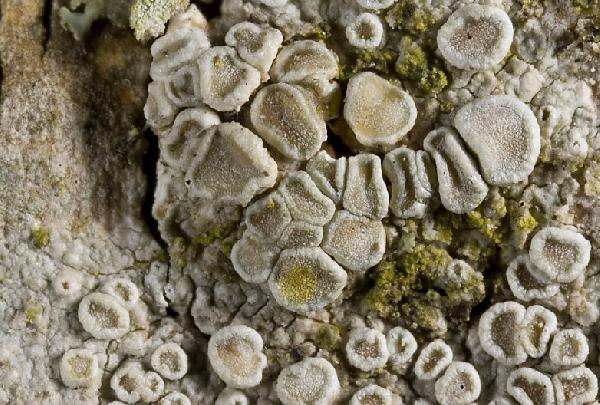Glaucomaria subcarpinea (Szatala) S.Y. Kondr., Lőkös & Farkas
in Kondratyuk & al., Acta Bot. Hung., 61, 1-2: 154, 2019. Basionym: Lecanora subcarpinea Szatala - Ann. Mus. Nat. Hungar., n. ser., 5: 136, 1954.
Synonyms: Lecanora leptyrodes auct. p.p.; Lecanora nemoralis auct. p.p. non Makar.; Lecanora subcarpinea Szatala
Distribution: N - Frl, Lomb (Gheza & al. 2023), VA (Matteucci & al. 2008c), Emil (Nimis & al. 1996, Grube & al. 2004, Fariselli & al. 2020). C - Marc (Nimis & Tretiach 1999), Abr (Nimis & Tretiach 1999, Caporale & al. 2016, Corona & al. 2016, Gheza & al. 2021), Mol (Nimis & Tretiach 1999, Caporale & al. 2008, Genovesi & Ravera 2014), Sar (Ravera & al. 2023). S - Pugl (Nimis & Tretiach 1999), Bas (Nimis & Tretiach 1999), Cal (Puntillo 1996).
Description: Thallus crustose, continuous or cracked, whitish to grey, smooth, epruinose, sometimes delimited by a white prothallus. Apothecia lecanorine, round to angular, sessile, rarely crowded, 0.8-2.2(-2.6) mm across with an orange-brown to flesh-coloured, but heavily white-pruinose, flat to slightly convex disc and a rather thin, persistent, prominent, usually not flexuose thalline margin. Thalline exciple with a pseudocortex (the hyphae of the medulla almost reaching the margin) containing crystals which are not readily soluble in K; proper exciple thin, colourless, filled with crystals; epithecium grey-brown, with fine crystans soluble in K; hymenium colourless, 50-80 µm high; paraphyses slightly thickened at apex (up to 2.5 µm) hypothecium colourless. Asci 8-spored, elongate-clavate, very thin-walled, with a K/I+ blue, tall tholus penetrated by a faintly amyloid apical cushion, the wall K/I-, surrounded by a K/I+ blue outer layer, Lecanora-type. Ascospores 1-celled, hyaline, simple, broadly ellipsoid, 10-13(-14) x 5.5-8 µm, the wall <1 µm thick. Photobiont chlorococcoid. Spot tests: thallus K+ yellow, C-; disc of apothecia (pruina) C+ bright lemon yellow to yellow-orange; margin of apothecia P+ intensely yellow to orange. Chemistry: thallus with atranorin (major), chloroatranorin (minor), psoromic acid, 2'-0-demethylpsoromic acid (minor); apothecia with sordidone (major).Note: on smooth bark of isolated trees. The Italian material of the G. carpinea-G. leptyrodes complex still needs revision: here I place all records of specimens similar to G. carpinea, and usually found on base-rich, sun-exposed bark, but with the apothecial margin reacting P+ bright yellow.
Growth form: Crustose
Substrata: bark
Photobiont: green algae other than Trentepohlia
Reproductive strategy: mainly sexual
Commonnes-rarity: (info)
Alpine belt: absent
Subalpine belt: absent
Oromediterranean belt: absent
Montane belt: rather rare
Submediterranean belt: rare
Padanian area: absent
Humid submediterranean belt: rather rare
Humid mediterranean belt: very rare
Dry mediterranean belt: very rare
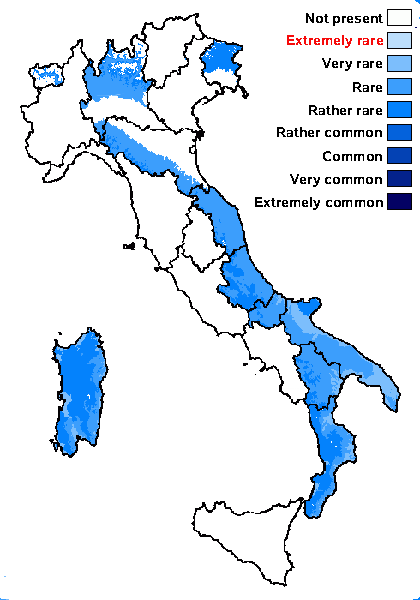
Predictive model
Herbarium samples
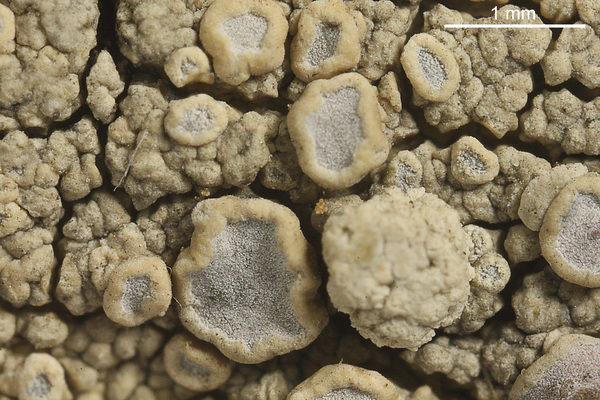

Felix Schumm – CC BY-SA 4.0
[5491], Süd-Deutschland, Schwäbische Alb, Kreis Tübingen, an der Nordkante der Hochfläche des Farrenbergs südlich Mössingen, 810 m; 48°23.206’ N, 9°04.577’ E, an Carpinus, TK: 7620. Leg. Schumm 03.04.1999, det. Schumm 03.04.1999.
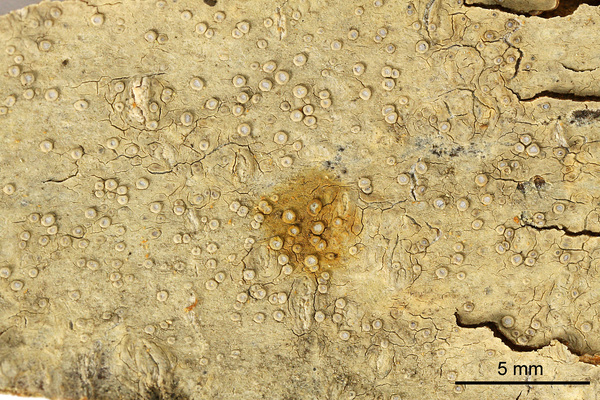

Felix Schumm – CC BY-SA 4.0
[5463], Süd-Deutschland, Schwäbische Alb, Kreis Reutlingen, ca. 4 km südl. Pfullingen beim Parkplatz zwischen Rößleshart und Gielsberg, 48°25.385' N, 9°12.587' E, ca. 800 m, an Fagus, TK: 7521. Leg. Schumm 30.03.1999, det Schumm 30.03.1999.
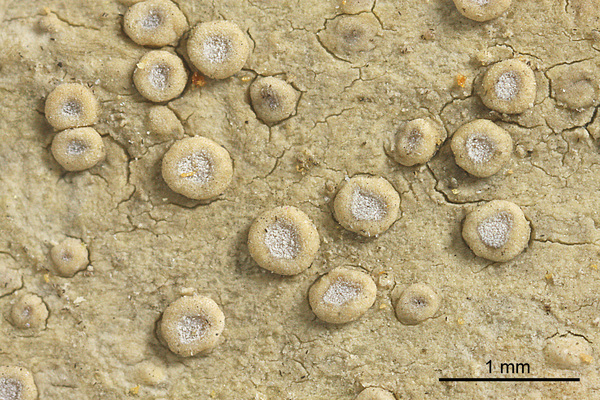

Felix Schumm – CC BY-SA 4.0
[5463], Süd-Deutschland, Schwäbische Alb, Kreis Reutlingen, ca. 4 km südl. Pfullingen beim Parkplatz zwischen Rößleshart und Gielsberg, 48°25.385' N, 9°12.587' E, ca. 800 m, an Fagus, TK: 7521. Leg. Schumm 30.03.1999, det Schumm 30.03.1999.
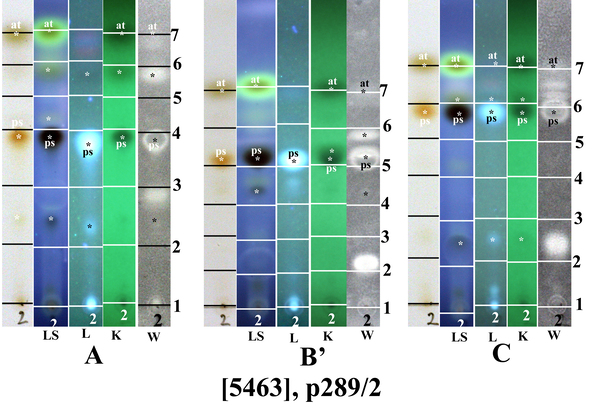

Felix Schumm – CC BY-SA 4.0
[5463], Süd-Deutschland, Schwäbische Alb, Kreis Reutlingen, ca. 4 km südl. Pfullingen beim Parkplatz zwischen Rößleshart und Gielsberg, 48°25.385' N, 9°12.587' E, ca. 800 m, an Fagus, TK: 7521. Leg. Schumm 30.03.1999, det Schumm 30.03.1999.
ps: psoromic acid; 2’-O-demethylpsoromic acid bei (2,4| 4,2 | 2,5); at: atranorin
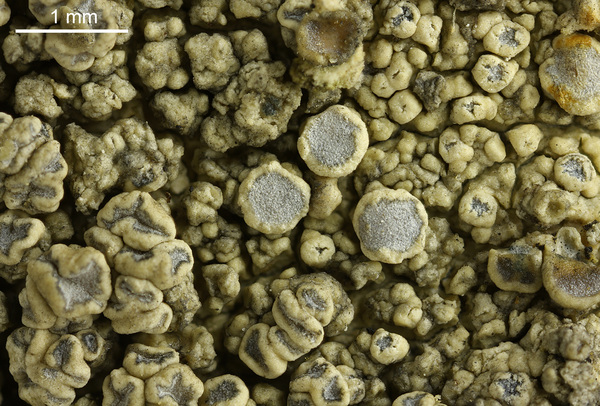

Felix Schumm – CC BY-SA 4.0
[5491], Süd-Deutschland, Schwäbische Alb, Kreis Tübingen, an der Nordkante der Hochfläche des Farrenbergs südlich Mössingen, 810 m; 48°23.206’ N, 9°04.577’ E, an Carpinus, TK: 7620. Leg. Schumm 03.04.1999, det. Schumm 03.04.1999.
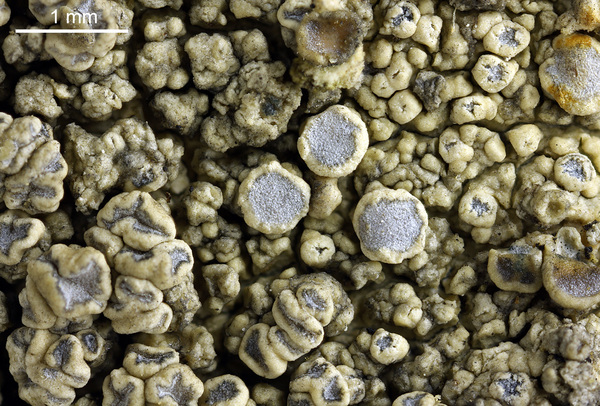

Felix Schumm – CC BY-SA 4.0
[5491], Süd-Deutschland, Schwäbische Alb, Kreis Tübingen, an der Nordkante der Hochfläche des Farrenbergs südlich Mössingen, 810 m; 48°23.206’ N, 9°04.577’ E, an Carpinus, TK: 7620. Leg. Schumm 03.04.1999, det. Schumm 03.04.1999.
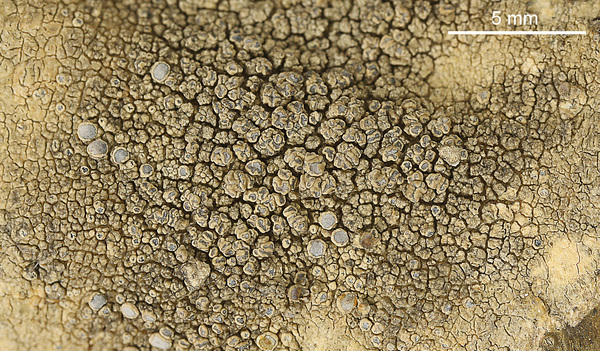

Felix Schumm – CC BY-SA 4.0
[5491], Süd-Deutschland, Schwäbische Alb, Kreis Tübingen, an der Nordkante der Hochfläche des Farrenbergs südlich Mössingen, 810 m; 48°23.206’ N, 9°04.577’ E, an Carpinus, TK: 7620. Leg. Schumm 03.04.1999, det. Schumm 03.04.1999.
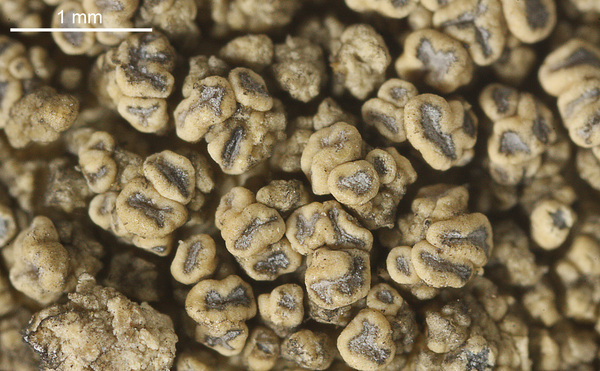

Felix Schumm – CC BY-SA 4.0
[5491], Süd-Deutschland, Schwäbische Alb, Kreis Tübingen, an der Nordkante der Hochfläche des Farrenbergs südlich Mössingen, 810 m; 48°23.206’ N, 9°04.577’ E, an Carpinus, TK: 7620. Leg. Schumm 03.04.1999, det. Schumm 03.04.1999.
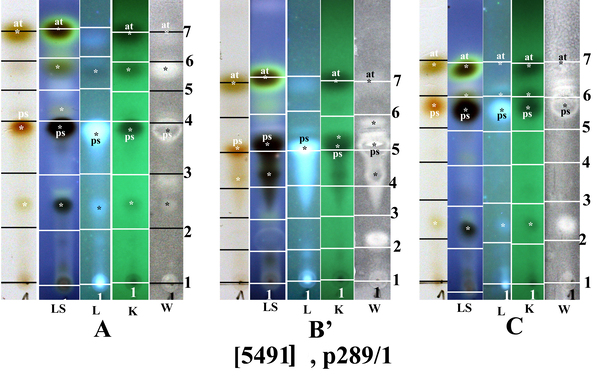

Felix Schumm – CC BY-SA 4.0
[5491], Süd-Deutschland, Schwäbische Alb, Kreis Tübingen, an der Nordkante der Hochfläche des Farrenbergs südlich Mössingen, 810 m; 48°23.206’ N, 9°04.577’ E, an Carpinus, TK: 7620. Leg. Schumm 03.04.1999, det. Schumm 03.04.1999.
ps: psoromic acid, at: atranorin
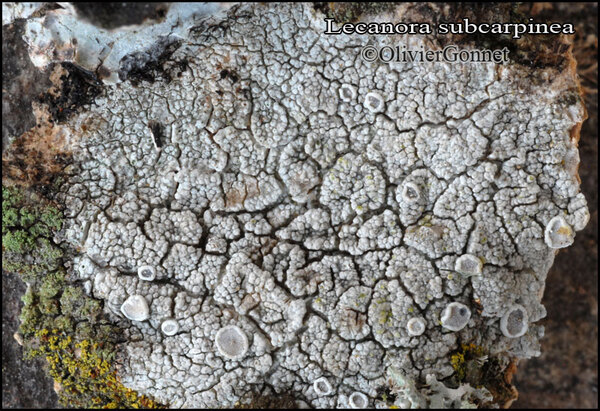
Courtesy Danièle et Olivier Gonnet - Source: https://www.afl-lichenologie.fr/Photos_AFL/Photos_AFL_L/Texte_L_3/Lecanora_subcarpinea.htm
France, Sur noyer - Chavaniac - Haute-Loire
22/11/2015
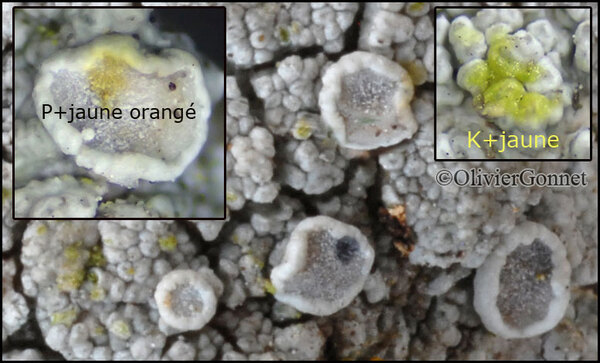
Courtesy Danièle et Olivier Gonnet - Source: https://www.afl-lichenologie.fr/Photos_AFL/Photos_AFL_L/Texte_L_3/Lecanora_subcarpinea.htm
France, Sur noyer - Chavaniac - Haute-Loire
22/11/2015
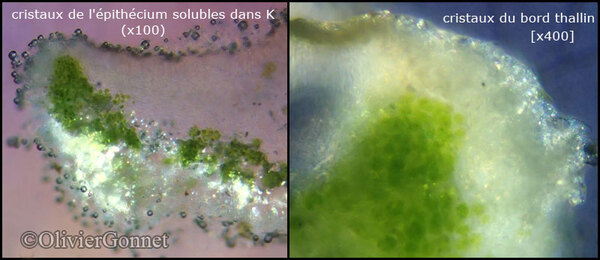
Courtesy Danièle et Olivier Gonnet - Source: https://www.afl-lichenologie.fr/Photos_AFL/Photos_AFL_L/Texte_L_3/Lecanora_subcarpinea.htm
France, Sur noyer - Chavaniac - Haute-Loire
22/11/2015
Growth form: Crustose
Substrata: bark
Photobiont: green algae other than Trentepohlia
Reproductive strategy: mainly sexual
Commonnes-rarity: (info)
Alpine belt: absent
Subalpine belt: absent
Oromediterranean belt: absent
Montane belt: rather rare
Submediterranean belt: rare
Padanian area: absent
Humid submediterranean belt: rather rare
Humid mediterranean belt: very rare
Dry mediterranean belt: very rare

Predictive model
| Herbarium samples |


Felix Schumm – CC BY-SA 4.0
[5491], Süd-Deutschland, Schwäbische Alb, Kreis Tübingen, an der Nordkante der Hochfläche des Farrenbergs südlich Mössingen, 810 m; 48°23.206’ N, 9°04.577’ E, an Carpinus, TK: 7620. Leg. Schumm 03.04.1999, det. Schumm 03.04.1999.


Felix Schumm – CC BY-SA 4.0
[5463], Süd-Deutschland, Schwäbische Alb, Kreis Reutlingen, ca. 4 km südl. Pfullingen beim Parkplatz zwischen Rößleshart und Gielsberg, 48°25.385' N, 9°12.587' E, ca. 800 m, an Fagus, TK: 7521. Leg. Schumm 30.03.1999, det Schumm 30.03.1999.


Felix Schumm – CC BY-SA 4.0
[5463], Süd-Deutschland, Schwäbische Alb, Kreis Reutlingen, ca. 4 km südl. Pfullingen beim Parkplatz zwischen Rößleshart und Gielsberg, 48°25.385' N, 9°12.587' E, ca. 800 m, an Fagus, TK: 7521. Leg. Schumm 30.03.1999, det Schumm 30.03.1999.


Felix Schumm – CC BY-SA 4.0
[5463], Süd-Deutschland, Schwäbische Alb, Kreis Reutlingen, ca. 4 km südl. Pfullingen beim Parkplatz zwischen Rößleshart und Gielsberg, 48°25.385' N, 9°12.587' E, ca. 800 m, an Fagus, TK: 7521. Leg. Schumm 30.03.1999, det Schumm 30.03.1999.
ps: psoromic acid; 2’-O-demethylpsoromic acid bei (2,4| 4,2 | 2,5); at: atranorin


Felix Schumm – CC BY-SA 4.0
[5491], Süd-Deutschland, Schwäbische Alb, Kreis Tübingen, an der Nordkante der Hochfläche des Farrenbergs südlich Mössingen, 810 m; 48°23.206’ N, 9°04.577’ E, an Carpinus, TK: 7620. Leg. Schumm 03.04.1999, det. Schumm 03.04.1999.


Felix Schumm – CC BY-SA 4.0
[5491], Süd-Deutschland, Schwäbische Alb, Kreis Tübingen, an der Nordkante der Hochfläche des Farrenbergs südlich Mössingen, 810 m; 48°23.206’ N, 9°04.577’ E, an Carpinus, TK: 7620. Leg. Schumm 03.04.1999, det. Schumm 03.04.1999.


Felix Schumm – CC BY-SA 4.0
[5491], Süd-Deutschland, Schwäbische Alb, Kreis Tübingen, an der Nordkante der Hochfläche des Farrenbergs südlich Mössingen, 810 m; 48°23.206’ N, 9°04.577’ E, an Carpinus, TK: 7620. Leg. Schumm 03.04.1999, det. Schumm 03.04.1999.


Felix Schumm – CC BY-SA 4.0
[5491], Süd-Deutschland, Schwäbische Alb, Kreis Tübingen, an der Nordkante der Hochfläche des Farrenbergs südlich Mössingen, 810 m; 48°23.206’ N, 9°04.577’ E, an Carpinus, TK: 7620. Leg. Schumm 03.04.1999, det. Schumm 03.04.1999.


Felix Schumm – CC BY-SA 4.0
[5491], Süd-Deutschland, Schwäbische Alb, Kreis Tübingen, an der Nordkante der Hochfläche des Farrenbergs südlich Mössingen, 810 m; 48°23.206’ N, 9°04.577’ E, an Carpinus, TK: 7620. Leg. Schumm 03.04.1999, det. Schumm 03.04.1999.
ps: psoromic acid, at: atranorin

Courtesy Danièle et Olivier Gonnet - Source: https://www.afl-lichenologie.fr/Photos_AFL/Photos_AFL_L/Texte_L_3/Lecanora_subcarpinea.htm
France, Sur noyer - Chavaniac - Haute-Loire
22/11/2015

Courtesy Danièle et Olivier Gonnet - Source: https://www.afl-lichenologie.fr/Photos_AFL/Photos_AFL_L/Texte_L_3/Lecanora_subcarpinea.htm
France, Sur noyer - Chavaniac - Haute-Loire
22/11/2015

 DOLICHENS
DOLICHENS
